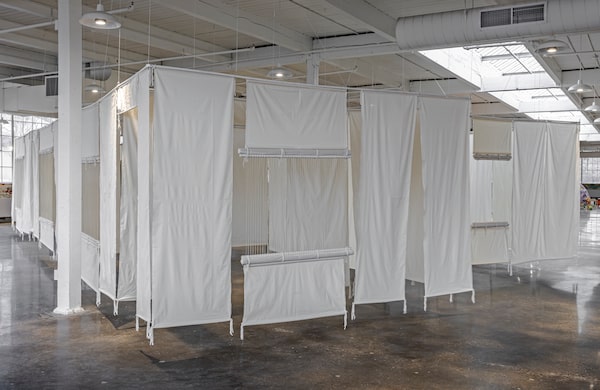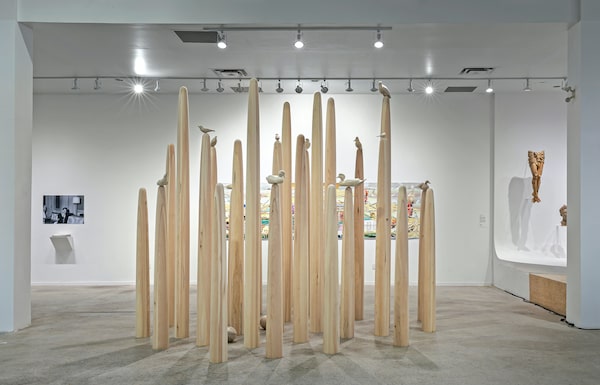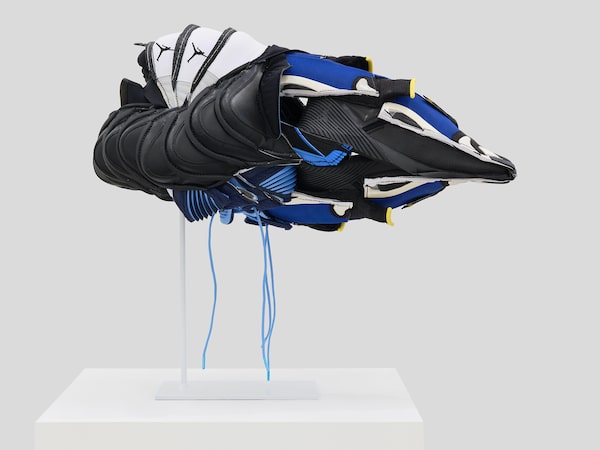
Artist Eric-Paul Riege has erected a full-scale replica of his childhood home using panels of woven fibre.Toni Hafkenscheid/Toronto Biennial of Art
Where there is water, there is life – which is why people settle along riverbanks and lakeshores. As the second Toronto Biennial of Art takes the meeting of water and land as its theme, there is a certain yearning in the art of three dozen Canadian and international creators displayed at nine different sites across this Great Lakes city. Some aim to mark a place; others long for home.
But as the exhibition, titled What Water Knows, The Land Remembers, addresses ecology, archeology, Indigeneity, history and kinship, not much of the art actually connects with contemporary Toronto and its urban themes.
The 2022 biennial’s main site is in the Junction Triangle, a Pentecostal church converted into a bright white box before it is to be demolished for the inevitable condos. There, the American Ojibwe artist Andrea Carlson has erected a small forest of wooden standing stones mounted by carvings of birds. The striking sculptural group is inspired in part by an ancient Woodland effigy mound in Wisconsin showing the figure of a man, his giant legs now cut off by a modern road.
At the charming Small Arms Inspection Building in Mississauga, an even airier site, the Diné (Navajo) artist Eric-Paul Riege has erected a full-scale replica of his childhood home using panels of woven fibre, an elegiac homage to the female weavers from whom he is descended. You can walk through this delicate bungalow, but outdoors, where the Lithuanian artist Augustas Serapinas has built a fire tower using materials from an abandoned shed he found on Newfoundland’s Fogo Island, there is no point of entry.
And back at Arsenal Contemporary in the Junction, the Amazonian artist and naturalist Abel Rodriguez contributes more of his meticulous drawings of rain-forest foliage and critters. An accompanying documentary follows him as he leaves Bogota to return to his traditional territory, seeking herbal remedies that might soothe his aging body.
Camille Turner's Nave is a three-channel video installation and soundscape.Toni Hafkenscheid/Toronto Biennial of Art
Rodriguez’s remarkable art, along with similarly detailed but more overtly spiritual compositions by his son Wilson Rodriguez (Aycoobo), were also a highlight of the first Toronto biennial back in 2019, an example of the intriguing international contributions that the event brings to town as it commissions art to respond to its themes. (The younger Rodriguez has just won the exhibition’s emerging artist prize.) On the other hand, few of the local artists included match this competition, and Toronto itself often feels like an afterthought.
The biennial, with this second outing delayed by the pandemic, is a good idea that deserves to succeed. Toronto, its art scene and its artists need more global exposure – so why not stage a high-profile international art show in the city?
While every other metropolis has its biennial, this one comes with a twist: It mainly commissions new and often site-specific work, rather than inviting art stars to ship in their latest gallery offerings. And it asks the artists to respond specifically to Toronto and its site – or perhaps Canada more generally. In a show curated by Candice Hopkins, Katie Lawson and Tairone Bastien, the emphasis on the Indigenous history of this place and a strong showing by international Indigenous artists help make the project stand out.
Perhaps the best example of what the approach can achieve is the excellent 45th Parallel, a short film by the Jordanian sound artist Lawrence Abu Hamdan that is screening continuously at the Mercer Union at Bloor and Lansdowne. Hamdan discovered the Haskell Free Library and Opera House on the Quebec-Vermont border – pick up a book in Canada, check it out in the U.S. – and used this transnational institution to tell two stories that illustrate the illogic of international frontiers.
One is an amusing tale about some gun runners who used the library to ply their cross-border trade; the other is a much darker and more distant story about a 2019 decision by the U.S. Supreme Court to block the prosecution of a border guard who was standing on American soil when he shot an unarmed teen in Mexico. The film is intelligent and provocative, yet utterly accessible, narrated by the Palestinian filmmaker Mahdi Fleifel and shot in the little library and its historic auditorium.
In contrast, Camille Turner’s three-channel video Nave, which won her the biennial’s artist prize, is beautiful but often opaque. Showing on three large screens in a room at the Small Arms Building, it features a dancer performing by the ocean and the Jamaican-Canadian artist herself enacting a ritual in a church. Eventually, the image of the church’s wooden rafters is cleverly inverted to become the hold of a ship. An exterior view shows a clapboard church in Newfoundland. The context, obliquely referred to in the curators’ accompanying text and mentioned in the audio guide for those who persist, is that the island’s shipbuilding industry produced slave ships, a subject the artist has researched extensively.
If anyone bothered to explain that upfront, it would make the connection with nearby charcoal drawings by the late Denyse Thomasos more evident. The Trinidadian-Canadian artist, who died in 2012, drew claustrophobic structures made up of small compartments that also evoke slave ships. (Didactic panels in this exhibition, which say it “draws from polyphonic histories sedimented in and around Toronto,” need a lot less art-speak and a lot more straightforward explanation of references that the viewer can’t be expected to know. As often in the curatorial realm, academic instincts compete against pluralist themes.)
One of the odd things about Nave is that the brick nave with the wooden rafters has nothing to do with Newfoundland: It is St. Thomas’s Anglican Church on Toronto’s Huron Street. As the curators tease out their themes in these multiple venues, visions of the city or even contemporary urbanity are often foggy.
That is why Brian Jungen’s Plague Mask series, showing in a venue on Lower Jarvis Street, is so refreshing, offering a direct engagement with the current moment. The three long-beaked plague doctor’s masks made from Nike Air Jordans feature a new development in the B.C. artist’s work making Indigenous masks from commercial sports equipment.
Last fall, the GTA 21 show at the Museum of Contemporary Art featured local artists more inclined to consider global identities than the city itself; now the biennial reinforces the suspicion that visual artists actually struggle to address Toronto. The biennial will culminate with an event at Sugar Beach where U.S. artist Judy Chicago will release clouds of coloured smoke in an environmental piece titled Tribute to Toronto. The city sure could use some explosive placemaking.
The Toronto Biennial of Art continues to June 5 at various venues.

American Ojibwe artist Andrea Carlson has erected a small forest of wooden standing stones mounted by carvings of birds.Toni Hafkenscheid/Toronto Biennial of Art
Not to be missed at the Toronto Biennial
At the Textile Museum of Canada, Double Vision is an exhibition of rare wall hangings and prints by the Inuk artist Jessie Oonark and her daughters Victoria Mamnguqsualuk and Janet Kigusiuq explaining how the women’s experience making clothing influenced their use of symmetry and shapes.
At Arsenal Contemporary, selections include a giant lattice of reflective tape by the Maori collective Mata Aho inspired by traditional weaving and chevron patterns. Another equally monumental effort is a long horizontal painting by Pakistan artist Waqas Khan that looks like a blank surface from a distance. Up close, a minute grid of varying whites reveals itself.
At the Museum of Contemporary Art, the Indigenous American artist Jeffrey Gibson has transformed the lobby into riot of colour and imagery, using traditional patterning, lots of stickers and his signature beading to create both wallpaper and nooks for lounging.

Brian Jungen’s Plague Mask series is showing in a venue on Lower Jarvis Street.RACHEL TOPHAM PHOTOGRAPHY/Toronto Biennial of Art
Sign up for The Globe’s arts and lifestyle newsletters for more news, columns and advice in your inbox.
 Kate Taylor
Kate Taylor